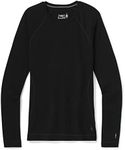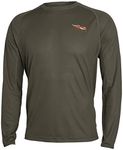Buying Guide for the Best Base Layer For Hunting
Choosing the right base layer for hunting is crucial for ensuring comfort, warmth, and overall performance during your outdoor adventures. The base layer is the first layer of clothing you wear, and it plays a significant role in moisture management and temperature regulation. When selecting a base layer, consider the material, weight, fit, and additional features that will best suit your hunting environment and activity level.MaterialThe material of the base layer is important because it affects moisture-wicking, breathability, and insulation. Common materials include merino wool, synthetic fabrics, and blends. Merino wool is excellent for temperature regulation and odor resistance, making it ideal for cold weather. Synthetic fabrics like polyester are great for moisture-wicking and quick drying, suitable for high-intensity activities. Blends offer a balance of both. Choose a material based on the climate and your activity level.
WeightThe weight of the base layer determines its warmth and suitability for different temperatures. Base layers come in lightweight, midweight, and heavyweight options. Lightweight base layers are best for mild to cool conditions and high-intensity activities as they provide good moisture-wicking and breathability. Midweight base layers offer more warmth and are suitable for cooler temperatures and moderate activity levels. Heavyweight base layers provide maximum insulation for very cold conditions and low-intensity activities. Select the weight based on the expected weather and your activity level.
FitThe fit of the base layer is crucial for comfort and performance. A snug fit is important for effective moisture-wicking and insulation, as it allows the fabric to stay close to your skin. However, it should not be too tight to restrict movement. Look for base layers with a form-fitting design that allows for a full range of motion. Consider your body shape and the type of hunting you will be doing when choosing the fit.
Moisture-WickingMoisture-wicking is the ability of the fabric to draw sweat away from your skin and disperse it across the surface for quick evaporation. This is important to keep you dry and comfortable, especially during high-intensity activities. Materials like merino wool and synthetic fabrics are known for their excellent moisture-wicking properties. Choose a base layer with good moisture-wicking capabilities to stay dry and prevent chills.
BreathabilityBreathability refers to the fabric's ability to allow air to circulate and release moisture vapor. This is important to prevent overheating and maintain comfort during physical activity. Merino wool and synthetic fabrics typically offer good breathability. Consider the level of activity and the climate when selecting a base layer with the appropriate breathability.
Odor ResistanceOdor resistance is the ability of the fabric to prevent the buildup of unpleasant smells caused by sweat and bacteria. This is particularly important for extended hunting trips where you may not have the opportunity to wash your base layer frequently. Merino wool naturally resists odors, while some synthetic fabrics are treated with antimicrobial finishes to achieve similar results. Choose a base layer with good odor resistance to stay fresh and comfortable.
DurabilityDurability refers to the fabric's ability to withstand wear and tear over time. This is important for ensuring that your base layer lasts through multiple hunting seasons. Look for high-quality materials and construction, such as reinforced seams and abrasion-resistant fabrics. Consider the type of hunting and the terrain you will be navigating when selecting a durable base layer.






















